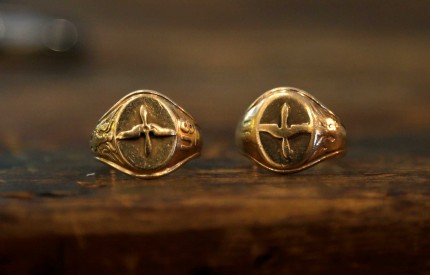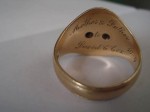 After the bombing of Pearl Harbor, David C. Cox dropped out of college and enlisted in the U.S. Army Air Corps. He graduated flight school on July 26, 1942. To celebrate, his parents gave him a gold ring with decorated with a wee propeller and wings and engraved “Mother & Father to David C. Cox Greensboro, NC 10-4-18-42” (his birthday and the current year) on the inside. Cox went sent to England with the 305th Bomb Group, 364th Squadron, where he flew a B-17 in bombing missions over Germany and occupied France.
After the bombing of Pearl Harbor, David C. Cox dropped out of college and enlisted in the U.S. Army Air Corps. He graduated flight school on July 26, 1942. To celebrate, his parents gave him a gold ring with decorated with a wee propeller and wings and engraved “Mother & Father to David C. Cox Greensboro, NC 10-4-18-42” (his birthday and the current year) on the inside. Cox went sent to England with the 305th Bomb Group, 364th Squadron, where he flew a B-17 in bombing missions over Germany and occupied France.
Cox flew more than a dozen missions, on one occasion winning the Distinguished Flying Cross when he helped bring his burning plane back after a raid killed half the 10-man crew. On July 28, 1943, he was not so fortunate. Cox’s plane was shot down over Kassel, Germany. He parachuted into a private garden where was captured and sent to Stalag Luft III, the Luftwaffe POW camp in Lower Silesia (now Poland) made famous by Steve McQueen in The Great Escape. He was imprisoned there for a year and a half before he and a few thousand other Allied officers were forced to march three days in the January snow and take a train for three more days until they reached Stalag VII-A, Germany’s largest POW camp near Moosburg, southern Bavaria.
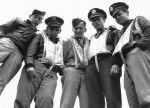 They were moved to keep ahead of the encroaching Soviet army. Allied prisoners from other POW camps under threat from the Soviets were also sent to Stalag VII-A. It had been built in 1939 to hold 10,000 Polish prisoners. By January of 1945 when David Cox arrived, there were 80,000 Allied prisoners. Conditions, needless to say, were atrocious. Barracks were painfully overcrowded and the Red Cross rations that had sustained the POWs had dwindled to nothing. The prisoners made do with insect-infested bread and thin soup. Starving, they would trade anything they had for a morsel of food. Cox, who had kept the gold ring through so much hardship, finally traded it for two chocolate bars an Italian POW had managed to scrounge up.
They were moved to keep ahead of the encroaching Soviet army. Allied prisoners from other POW camps under threat from the Soviets were also sent to Stalag VII-A. It had been built in 1939 to hold 10,000 Polish prisoners. By January of 1945 when David Cox arrived, there were 80,000 Allied prisoners. Conditions, needless to say, were atrocious. Barracks were painfully overcrowded and the Red Cross rations that had sustained the POWs had dwindled to nothing. The prisoners made do with insect-infested bread and thin soup. Starving, they would trade anything they had for a morsel of food. Cox, who had kept the gold ring through so much hardship, finally traded it for two chocolate bars an Italian POW had managed to scrounge up.
On April 29th, 1945, by Combat Command A of the 14th Armored Division liberated Stalag VII-A. They didn’t even know the camp was there until a few hours before the battle began when a delegation of one SS officer, one Red Cross representative and two Allied officer POWs approached the command post offering surrender terms. The army’s tactical goal of capturing a bridge across the Isar river could not be achieved if they accepted the surrender, so instead the 14th Armored Division forewent an artillery assault to avoid harming the POWs. The Germans destroyed the bridge before the Americans could capture it, so technically they failed in their mission, but they defeated the German defenders at Moosburg anyway and liberated the camp.
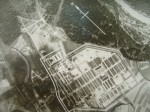 They were shocked to find 110,000 prisoners in Stalag VII-A, 30,000 of them Americans. The liberation of so many POWs at once quickly overshadowed the issue of the bridge, and Moosburg became a point of pride. General George S. Patton, commander of Third Army, visited the camp in person.
They were shocked to find 110,000 prisoners in Stalag VII-A, 30,000 of them Americans. The liberation of so many POWs at once quickly overshadowed the issue of the bridge, and Moosburg became a point of pride. General George S. Patton, commander of Third Army, visited the camp in person.
Once liberated, David Cox was promoted to 1st lieutenant and sent home to North Carolina where his wife Hilda, his parents and siblings were waiting for him. He and Hilda would go on to have three children. David didn’t talk much about his war experience, but one story he told often was how he had had to give up his beloved ring. He had an exact duplicate made shortly after his return and he wore it religiously until shortly before his death in 1994. He bequeathed the replica ring to his son David C. Cox, Jr., who wore it until the band snapped.
 Last year, Americans Mark and Mindy Turner moved to the Bavarian village of Hohenberg where Mark got a job as an air traffic controller at the US Army garrison in nearby Ansbach. Earlier this month, the Turners went to dinner at the house of their neighbors Martin and Regina Kiss. After a tour of Martin’s art studio, Martin showed the Turners a special treasure of his: a gold ring with a wee propeller on top and a dedication to a certain David C. Cox engraved on the inside.
Last year, Americans Mark and Mindy Turner moved to the Bavarian village of Hohenberg where Mark got a job as an air traffic controller at the US Army garrison in nearby Ansbach. Earlier this month, the Turners went to dinner at the house of their neighbors Martin and Regina Kiss. After a tour of Martin’s art studio, Martin showed the Turners a special treasure of his: a gold ring with a wee propeller on top and a dedication to a certain David C. Cox engraved on the inside.
He then told them the story of how he had acquired the ring. The Kiss family hails from an ethnically Hungarian area in what is today northern Serbia. Kiss’ grandparents ran a pub. When a Soviet soldier stopped there on his way home after the war, he traded the gold ring in exchange for food and lodging. Grandmama Kiss gave the ring to Martin in 1971. By then it had become something of a good luck amulet for the family, and Martin was moving to Germany so his grandmother wanted him to have the ring to bring him good fortune in his new life and to give him something to sell if he was ever in extreme need. He wore it as a pinkie ring for a while, but then put it in a corked bottle for safekeeping.
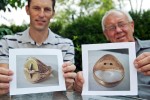 Martin Kiss had always been curious about the owner of the ring. He asked the Turners if they could help find him, and thanks to that detailed inscription and the wonders of Google, Mark Turner found a reference to David C. Cox’s war experience and how he had had to trade his gold ring for two chocolate bars in a thesis written by Norwood McDowell, husband of one of Cox’s granddaughters. Mark emailed McDowell a picture of Martin Kiss’ ring. McDowell forwarded it to David Cox, Jr., and he confirmed that that was his father’s precious long-lost ring.
Martin Kiss had always been curious about the owner of the ring. He asked the Turners if they could help find him, and thanks to that detailed inscription and the wonders of Google, Mark Turner found a reference to David C. Cox’s war experience and how he had had to trade his gold ring for two chocolate bars in a thesis written by Norwood McDowell, husband of one of Cox’s granddaughters. Mark emailed McDowell a picture of Martin Kiss’ ring. McDowell forwarded it to David Cox, Jr., and he confirmed that that was his father’s precious long-lost ring.
Martin Kiss insisted on returning the ring, no questions asked, no remuneration, not even shipping costs, accepted. His grandfather had been a POW in Soviet camps, so he knew what the ring would mean to the family. On Friday, August 16th, David C. Cox’s ring was in his son’s hands for the first time.
“I thought about him the moment I opened the box,” Cox, who is 67, says of his father and the return of that ring, “and I thought how wonderful it would be if he were the one doing it rather than me. I’m sorry he can’t be here for it … He would have been overwhelmed like we are. He would have loved it.”
Cox also wonders about where that ring was over the years. “What did he do with it?,” he asks about the Italian POW. “How long did he keep it? … For it to go through all of those twists and turns and never leave within two hours of where the prison camp was … is a phenomenal story to me.”
Also phenomenal is the condition of the original ring. Despite having been in a plane fire, shot out of the sky, through two awful POW camps and at least four sets of hands since it was made, it’s in far better condition than the replica.
